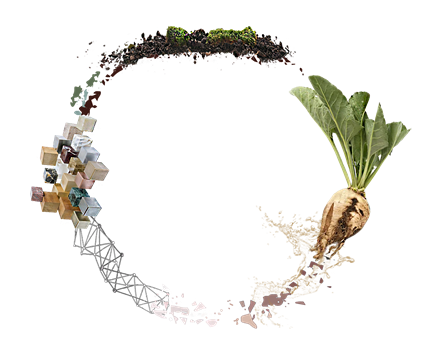Novo Nordisk Foundation supports Empa researchers
Making better use of sugar beet – thanks to Empa know-how
More than 250 million metric tons of sugar beet were harvested worldwide in 2020 and processed into table sugar. Most of the residues from sugar production end up in the stomachs of farm animals. But their components could also be used for health-promoting foodstuff and novel materials. Together with colleagues from Denmark, Empa researchers are working on this.

Grayish yellow, weighing up to around 1.2 kilograms, one-fifth of it sugar: The sugar beet, once bred from the beet, has served as a major supplier of sucrose for more than two centuries. In 2020, around 1.4 million metric tons were harvested in Switzerland, and more than 150 million in Europe as a whole – in other words, a mass product that not only supplies household sugar, but also, after further processing, delicate syrup before the fibrous residues end up shredded in the stomachs of cows and other farm animals.
An inconspicuous star of agriculture – and yet still underestimated, according to experts. This is because the cell walls contain polysaccharides such as cellulose, pectin and related compounds that have useful properties – for example, as a basis for anti-inflammatory foods or for recyclable materials made from cellulose fibers, on which Empa researchers led by Gustav Nyström have been working for a while.
With the research project SUgar Beet REvolution: Enzymatic Biorefining of Sugar Beet Pulp to Nutraceuticals and Recyclable Materials – SURE for short – a team of researchers in Denmark and at Empa now wants to lay the foundations for making sugar beet even more valuable in the future. The project (see info box below) is funded by the Danish Novo Nordisk Foundation to the tune of 7.7 million Swiss francs.
Four major challenges

An impressive sum, commensurate with the tasks the experts, led by biotechnologist Anne S. Meyer of Denmark's Technical University (DTU), will face. Four challenges have been defined for the project: creating new foundations for the efficient and gentle separation of intact cell wall structures with the aid of enzymes, and investigating how pectin compounds from sugar beet affect health in detail, for example in inflammatory processes.
From a materials science perspective, bio-based processes are also being explored to obtain high-strength nanocellulose from beets. And Empa experts from Nyström's Cellulose & Wood Materials lab will conduct basic research with a view to practical applications. For example, on the question of how dispersions of nanocellulose particles could be used to create materials such as gels, glass-like structures or liquid crystals. And how these could in turn be used to produce useful materials.
SURE is an ambitious and interdisciplinary project with great potential for practical applications that will serve sustainability and, in the long-term help to promote the use of biomass. "I am very pleased to have the opportunity to work together with our colleagues from Denmark on this strategically important topic," says Empa researcher Nyström. "We will jointly investigate new ways to valorize sugar beet biomass and also develop new strategies to use these materials in recyclable composites."
SURE – a Sugar Beet Revolution
The research project SUgar Beet REvolution: Enzymatic Biorefing of Sugar Beet Pulp to Nutraceuticals and Recyclable Materials (SURE) is one of several projects funded by the Novo Nordisk Foundation as part of its Recycling for a sustainable society program. The total funding for SURE is the equivalent of 7.7 million Swiss francs. The project is being led by researchers at Denmark's Technical University (DTU). In addition to Empa, another DTU research group and the University of Copenhagen are also involved. The project is scheduled to run for a total of six years.
Dr. Gustav Nyström
Cellulose & Wood Materials Laboratory
Phone +41 58 765 45 83
-
Share






